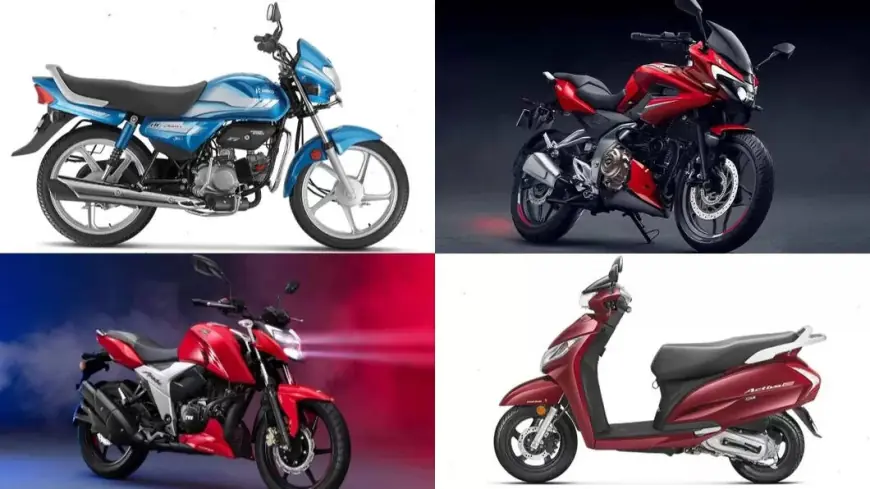Two-Wheeler Market 2030 Industry Size, Forecast & Share
The growing popularity of electric two-wheelers, driven by stricter emissions norms and consumer interest in sustainable transport, is opening new avenues for manufacturers and startups alike.

The global two-wheeler market is entering a dynamic new era. As of 2024, it was valued at approximately USD 686.88 billion and is projected to reach USD 797.51 billion by 2030, growing at a CAGR of 2.52% during the forecast period. While traditional motorcycles and scooters continue to dominate roads in emerging economies, a quiet revolution is underway—shaped by changing consumer behavior, sustainability imperatives, evolving mobility patterns, and technological breakthroughs.
From the rise of electric vehicles to the transformation of two-wheelers into key enablers of last-mile logistics and lifestyle products, the market is witnessing broad-spectrum shifts. This article explores the emerging trends, key drivers, and strategic forecasts shaping the future of the global two-wheeler industry.
Emerging Trends Transforming the Two-Wheeler Landscape
1. Electrification at the Forefront
Electric two-wheelers have become the face of innovation in this market. With growing concerns around carbon emissions and fossil fuel dependency, the adoption of electric scooters and motorcycles is rapidly gaining traction. The availability of government subsidies, tax rebates, and infrastructure investments—like EV charging networks—have substantially boosted electric two-wheeler sales.
Notably, electric vehicles are now offering:
- Higher energy density batteries
- Fast-charging capability
- Lower total cost of ownership
- Smart features like GPS, IoT-based diagnostics, and anti-theft solutions
These advances are not only easing range anxiety but are also attracting first-time buyers in urban and semi-urban regions.
Download Free Sample Report: https://www.techsciresearch.com/sample-report.aspx?cid=1416
2. Lifestyle Branding and Premiumization
Motorcycles are no longer just commuting vehicles; they are evolving into lifestyle products. In upper-middle-income and high-income countries, touring and adventure motorcycles are growing in popularity. Brand loyalty, design aesthetics, and customization are becoming critical purchase drivers. This trend is particularly evident in segments dominated by Harley-Davidson, BMW Motorrad, and Royal Enfield.
3. Integration with E-Commerce & Gig Economy
Two-wheelers have become essential tools for logistics, particularly last-mile deliveries. The rapid growth of e-commerce and gig platforms such as food delivery and courier services has increased demand for affordable and fuel-efficient scooters and motorcycles. Companies are even customizing fleets for delivery riders with ergonomic designs, larger storage, and fleet management tools.
4. Digital Connectivity & Smart Vehicles
The integration of digital technologies in two-wheelers is gaining momentum. Features like Bluetooth-enabled dashboards, connected mobile apps, voice commands, digital keys, and onboard navigation are transforming user experiences and enhancing rider safety. Some OEMs are experimenting with AI-based adaptive riding systems and predictive maintenance analytics.
5. Modular Manufacturing and Localization
OEMs are focusing on modular platforms to cater to diverse consumer segments with minimal production variations. This approach is reducing costs and accelerating time-to-market. Additionally, localized manufacturing and regional assembly units are helping companies penetrate untapped regions and avoid tariff barriers.
Key Market Drivers Boosting Two-Wheeler Growth
Rising Urbanization and Traffic Congestion
In densely populated urban centers, traffic congestion and lack of parking space make two-wheelers a practical alternative to cars. Their ability to navigate narrow roads and park in tight spaces makes them ideal for short commutes.
Youthful Demographics and Affordability
Younger consumers are opting for two-wheelers due to affordability, independence, and the ability to avoid shared transport post-pandemic. In emerging economies, they often serve as the first motorized vehicle for a household.
Government Incentives for EV Adoption
Subsidies, tax relief, free registration, and reduced toll charges for electric two-wheelers are playing a pivotal role in shifting consumer preferences. Many governments are also supporting EV battery manufacturing and public-private partnerships for charging infrastructure.
Underdeveloped Public Transportation in Emerging Markets
In many developing regions, inefficient or insufficient public transport has made two-wheelers an essential means of daily commuting. They offer a low-cost, readily available alternative, especially in peri-urban and rural areas.
Technological Advancements in Battery and Motor Design
Breakthroughs in lithium-ion battery technology and hub motors have improved the performance, longevity, and safety of electric two-wheelers, further encouraging their adoption across urban areas.
Industry Key Highlights
- Electric Two-Wheelers are now the fastest-growing propulsion type.
- Scooters and Mopeds are gaining ground over motorcycles in many Asian countries due to ease of use.
- Middle East & Africa emerged as the fastest-growing regional segment in 2024.
- Online sales platforms for two-wheelers are witnessing significant traction post-COVID-19.
- OEMs and startups are collaborating on battery-swapping networks to ease adoption barriers.
Market Segmentation Overview
The global two-wheeler market is segmented based on:
1. Vehicle Type
- Motorcycles
- Scooters/Mopeds
2. Propulsion Type
- Internal Combustion Engine (ICE)
- Electric
3. By Region
- North America
- Asia-Pacific
- Europe
- Middle East & Africa
- South America
Regional Insights
Middle East & Africa: A Rising Star
The Middle East & Africa region showed the highest YoY growth in two-wheeler adoption in 2024. The region’s informal economy, combined with its growing delivery sector, is creating strong demand for affordable and reliable two-wheelers. Regulatory incentives and pilot projects for EV charging infrastructure are encouraging investment from both OEMs and fintech-backed vehicle leasing startups.
Asia-Pacific: The Market Leader
Asia-Pacific remains the largest market, with countries like India, Vietnam, and Indonesia leading in volumes. These nations are rapidly transitioning towards electric mobility, supported by national EV policies and growing consumer awareness.
Future Outlook: What Lies Ahead
The global two-wheeler market is set to grow steadily through 2030, shaped by technological advances, demographic shifts, and evolving urban mobility needs. Electric propulsion will likely dominate new model launches by the end of the decade, while shared mobility applications such as e-scooter rentals will flourish in smart cities.
Additionally, as battery recycling and second-life applications evolve, the sustainability quotient of two-wheelers will improve further. OEMs will also prioritize over-the-air (OTA) updates, AI-enabled safety systems, and autonomous riding features in premium segments.
Competitive Analysis: Leading Players & Strategies
Some of the major players in the global two-wheeler market include:
- Hero MotoCorp Ltd. – Dominant in India with a wide portfolio of fuel-efficient motorcycles.
- Bajaj Auto Ltd. – Known for its value pricing and global export strategy.
- Yamaha Motor Co., Ltd. – Focuses on performance-driven bikes and emerging electric platforms.
- TVS Motor Company – Rapidly innovating in both ICE and electric segments.
- Honda Motor Co., Ltd. – One of the largest manufacturers globally, with a strong dealer network.
- Piaggio & C. S.p.A. – A leader in the premium scooter segment, especially in Europe.
- Harley-Davidson – A symbol of American lifestyle motorcycling.
- BMW Motorrad – Emphasizes high-end performance and touring motorcycles.
- Kawasaki Heavy Industries – Known for innovation in sport and adventure bikes.
- Suzuki Motor Corporation – Offers a balanced portfolio across motorcycles and scooters.
Key Competitive Strategies Include:
- Launching electric models tailored to local needs
- Collaborating with battery technology firms
- Investing in online and omnichannel retailing
- Expanding after-sales and roadside assistance networks
- Enhancing digital integration through apps and smart dashboards
10 Key Benefits of the Two-Wheeler Market Research Report
- In-depth Market Forecast: Covers market size and expected CAGR through 2030.
- Segmental Insights: Breaks down the market by vehicle type, propulsion, and region.
- Emerging Trend Analysis: Identifies next-gen technologies and mobility behaviors.
- Competitive Benchmarking: Profiles leading players with SWOT and strategy analysis.
- Regional Focus: Detailed breakdown of high-growth regions.
- Policy Review: Analysis of government incentives and subsidies for EVs.
- Consumer Behavior Insights: Covers buyer demographics and usage patterns.
- EV Transition Mapping: Tracks progress of electric two-wheeler adoption.
- Supply Chain Evaluation: Looks at manufacturing, distribution, and logistics.
- Customizable Reporting: Offers tailored insights with up to 10% free customization.
Conclusion: Steering Into the Future
The global two-wheeler market is poised for long-term growth, driven by environmental consciousness, urban mobility challenges, and consumer preference for affordable and flexible transportation. The proliferation of electric two-wheelers, digital integration, and lifestyle-driven buying behaviors are redefining how two-wheelers are perceived and used.
For stakeholders—including manufacturers, suppliers, investors, and governments—this period represents a window of opportunity to innovate, collaborate, and scale sustainably. The next wave of growth will depend on the ability to adapt to fast-changing consumer needs, integrate clean technologies, and ensure seamless mobility experiences for millions across the globe.
Contact Us-
Mr. Ken Mathews
708 Third Avenue,
Manhattan, NY,
New York – 10017
Tel: +1-646-360-1656
Email: [email protected]
Website: www.techsciresearch.com
What's Your Reaction?
 Like
0
Like
0
 Dislike
0
Dislike
0
 Love
0
Love
0
 Funny
0
Funny
0
 Angry
0
Angry
0
 Sad
0
Sad
0
 Wow
0
Wow
0




















































